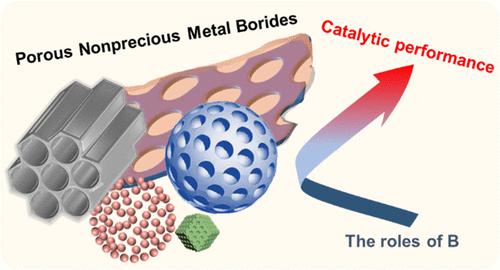当前位置:
X-MOL 学术
›
ACS Catal.
›
论文详情
Our official English website, www.x-mol.net, welcomes your
feedback! (Note: you will need to create a separate account there.)
Porous Nanoarchitectures of Nonprecious Metal Borides: From Controlled Synthesis to Heterogeneous Catalyst Applications
ACS Catalysis ( IF 11.3 ) Pub Date : 2022-11-18 , DOI: 10.1021/acscatal.2c03480
Yunqing Kang 1, 2 , Yi Tang 2 , Liyang Zhu 3 , Bo Jiang 4 , Xingtao Xu 2 , Olga Guselnikova 2 , Hexing Li 4 , Toru Asahi 1, 3, 5 , Yusuke Yamauchi 2, 3, 5, 6
ACS Catalysis ( IF 11.3 ) Pub Date : 2022-11-18 , DOI: 10.1021/acscatal.2c03480
Yunqing Kang 1, 2 , Yi Tang 2 , Liyang Zhu 3 , Bo Jiang 4 , Xingtao Xu 2 , Olga Guselnikova 2 , Hexing Li 4 , Toru Asahi 1, 3, 5 , Yusuke Yamauchi 2, 3, 5, 6
Affiliation

|
Porous nonprecious metal-based nanomaterials have gained considerable attention in heterogeneous catalysis owing to their low price, high specific surface area, efficient mass/electron transfer, tunable pore structure, and unique physicochemical properties. Controlling the phase and compositions of these porous nonprecious metal-based materials is critical to their applications. Porous nonprecious transition-metal borides (TMBs), typical metal–metalloid alloys, have recently received much interest because of their optimized electronic structure, adjustable crystal phase, and abundant active site. The controlled tuning of the porous structure of TMBs, exploring the relationship between the structure and performance, and understanding the function of B are essential for developing catalysts with excellent performance; however, these factors have rarely been reviewed. Herein, a detailed summary of the synthesis methods of porous TMBs is provided by precisely defining their shape, composition, and pore size/structure. Incorporating B into metals can significantly alter their performance due to the unique metalloid properties of B. Further, we focus on the key roles of B in porous TMBs for related heterogeneous catalytic applications, including phase control, regulated electronic structure, optimized adsorption of reaction intermediates, and enhanced charge transfer and stability. Finally, we outline the shortcomings, challenges, and possible development of porous TMBs, which need to be further explored to increase TMBs’ contribution to heterogeneous catalyst applications and beyond.
中文翻译:

非贵金属硼化物的多孔纳米结构:从可控合成到多相催化剂应用
多孔非贵金属基纳米材料由于其低廉的价格、高比表面积、高效的质量/电子转移、可调的孔结构和独特的物理化学性质,在多相催化领域受到了广泛关注。控制这些多孔非贵金属基材料的相和组成对其应用至关重要。多孔非贵重过渡金属硼化物 (TMB) 是典型的金属-类金属合金,由于其优化的电子结构、可调节的晶相和丰富的活性位点,最近受到了广泛关注。TMBs多孔结构的可控调节,探索结构与性能之间的关系,了解B的功能对于开发具有优异性能的催化剂至关重要;然而,这些因素很少受到审查。在此,通过精确定义多孔 TMB 的形状、组成和孔径/结构,对多孔 TMB 的合成方法进行了详细总结。由于 B 独特的类金属性质,将 B 掺入金属中可以显着改变其性能。此外,我们关注 B 在多孔 TMB 中的关键作用,用于相关的多相催化应用,包括相控制、调节电子结构、反应中间体的优化吸附,并增强电荷转移和稳定性。最后,我们概述了多孔 TMB 的缺点、挑战和可能的发展,需要进一步探索以增加 TMB 对多相催化剂应用及其他应用的贡献。通过精确定义其形状、组成和孔径/结构,提供了多孔 TMB 合成方法的详细摘要。由于 B 独特的类金属性质,将 B 掺入金属中可以显着改变其性能。此外,我们关注 B 在多孔 TMB 中的关键作用,用于相关的多相催化应用,包括相控制、调节电子结构、反应中间体的优化吸附,并增强电荷转移和稳定性。最后,我们概述了多孔 TMB 的缺点、挑战和可能的发展,需要进一步探索以增加 TMB 对多相催化剂应用及其他应用的贡献。通过精确定义其形状、组成和孔径/结构,提供了多孔 TMB 合成方法的详细摘要。由于 B 独特的类金属性质,将 B 掺入金属中可以显着改变其性能。此外,我们关注 B 在多孔 TMB 中的关键作用,用于相关的多相催化应用,包括相控制、调节电子结构、反应中间体的优化吸附,并增强电荷转移和稳定性。最后,我们概述了多孔 TMB 的缺点、挑战和可能的发展,需要进一步探索以增加 TMB 对多相催化剂应用及其他应用的贡献。由于 B 独特的类金属性质,将 B 掺入金属中可以显着改变其性能。此外,我们关注 B 在多孔 TMB 中的关键作用,用于相关的多相催化应用,包括相控制、调节电子结构、反应中间体的优化吸附,并增强电荷转移和稳定性。最后,我们概述了多孔 TMB 的缺点、挑战和可能的发展,需要进一步探索以增加 TMB 对多相催化剂应用及其他应用的贡献。由于 B 独特的类金属性质,将 B 掺入金属中可以显着改变其性能。此外,我们关注 B 在多孔 TMB 中的关键作用,用于相关的多相催化应用,包括相控制、调节电子结构、反应中间体的优化吸附,并增强电荷转移和稳定性。最后,我们概述了多孔 TMB 的缺点、挑战和可能的发展,需要进一步探索以增加 TMB 对多相催化剂应用及其他应用的贡献。并增强电荷转移和稳定性。最后,我们概述了多孔 TMB 的缺点、挑战和可能的发展,需要进一步探索以增加 TMB 对多相催化剂应用及其他应用的贡献。并增强电荷转移和稳定性。最后,我们概述了多孔 TMB 的缺点、挑战和可能的发展,需要进一步探索以增加 TMB 对多相催化剂应用及其他应用的贡献。
更新日期:2022-11-18
中文翻译:

非贵金属硼化物的多孔纳米结构:从可控合成到多相催化剂应用
多孔非贵金属基纳米材料由于其低廉的价格、高比表面积、高效的质量/电子转移、可调的孔结构和独特的物理化学性质,在多相催化领域受到了广泛关注。控制这些多孔非贵金属基材料的相和组成对其应用至关重要。多孔非贵重过渡金属硼化物 (TMB) 是典型的金属-类金属合金,由于其优化的电子结构、可调节的晶相和丰富的活性位点,最近受到了广泛关注。TMBs多孔结构的可控调节,探索结构与性能之间的关系,了解B的功能对于开发具有优异性能的催化剂至关重要;然而,这些因素很少受到审查。在此,通过精确定义多孔 TMB 的形状、组成和孔径/结构,对多孔 TMB 的合成方法进行了详细总结。由于 B 独特的类金属性质,将 B 掺入金属中可以显着改变其性能。此外,我们关注 B 在多孔 TMB 中的关键作用,用于相关的多相催化应用,包括相控制、调节电子结构、反应中间体的优化吸附,并增强电荷转移和稳定性。最后,我们概述了多孔 TMB 的缺点、挑战和可能的发展,需要进一步探索以增加 TMB 对多相催化剂应用及其他应用的贡献。通过精确定义其形状、组成和孔径/结构,提供了多孔 TMB 合成方法的详细摘要。由于 B 独特的类金属性质,将 B 掺入金属中可以显着改变其性能。此外,我们关注 B 在多孔 TMB 中的关键作用,用于相关的多相催化应用,包括相控制、调节电子结构、反应中间体的优化吸附,并增强电荷转移和稳定性。最后,我们概述了多孔 TMB 的缺点、挑战和可能的发展,需要进一步探索以增加 TMB 对多相催化剂应用及其他应用的贡献。通过精确定义其形状、组成和孔径/结构,提供了多孔 TMB 合成方法的详细摘要。由于 B 独特的类金属性质,将 B 掺入金属中可以显着改变其性能。此外,我们关注 B 在多孔 TMB 中的关键作用,用于相关的多相催化应用,包括相控制、调节电子结构、反应中间体的优化吸附,并增强电荷转移和稳定性。最后,我们概述了多孔 TMB 的缺点、挑战和可能的发展,需要进一步探索以增加 TMB 对多相催化剂应用及其他应用的贡献。由于 B 独特的类金属性质,将 B 掺入金属中可以显着改变其性能。此外,我们关注 B 在多孔 TMB 中的关键作用,用于相关的多相催化应用,包括相控制、调节电子结构、反应中间体的优化吸附,并增强电荷转移和稳定性。最后,我们概述了多孔 TMB 的缺点、挑战和可能的发展,需要进一步探索以增加 TMB 对多相催化剂应用及其他应用的贡献。由于 B 独特的类金属性质,将 B 掺入金属中可以显着改变其性能。此外,我们关注 B 在多孔 TMB 中的关键作用,用于相关的多相催化应用,包括相控制、调节电子结构、反应中间体的优化吸附,并增强电荷转移和稳定性。最后,我们概述了多孔 TMB 的缺点、挑战和可能的发展,需要进一步探索以增加 TMB 对多相催化剂应用及其他应用的贡献。并增强电荷转移和稳定性。最后,我们概述了多孔 TMB 的缺点、挑战和可能的发展,需要进一步探索以增加 TMB 对多相催化剂应用及其他应用的贡献。并增强电荷转移和稳定性。最后,我们概述了多孔 TMB 的缺点、挑战和可能的发展,需要进一步探索以增加 TMB 对多相催化剂应用及其他应用的贡献。































 京公网安备 11010802027423号
京公网安备 11010802027423号